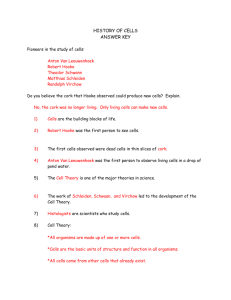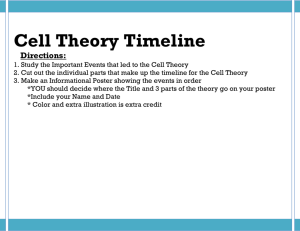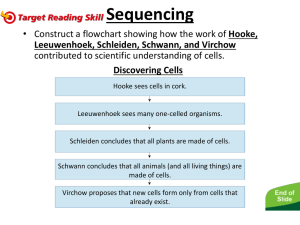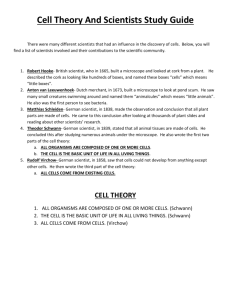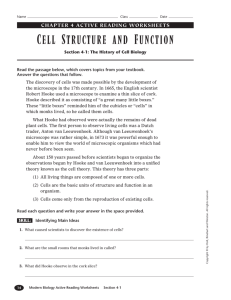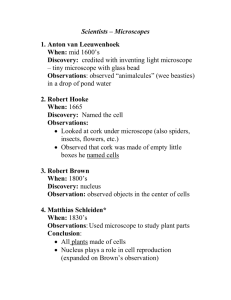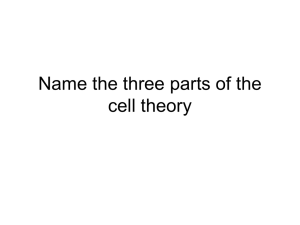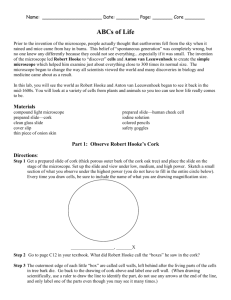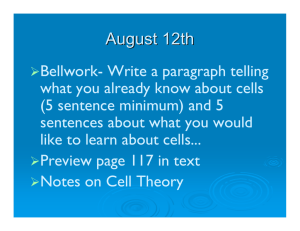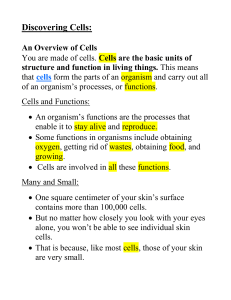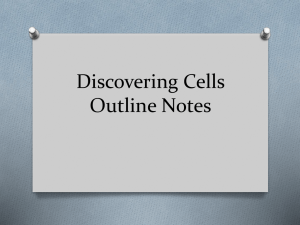Cell Theory Notes for Middle School Science
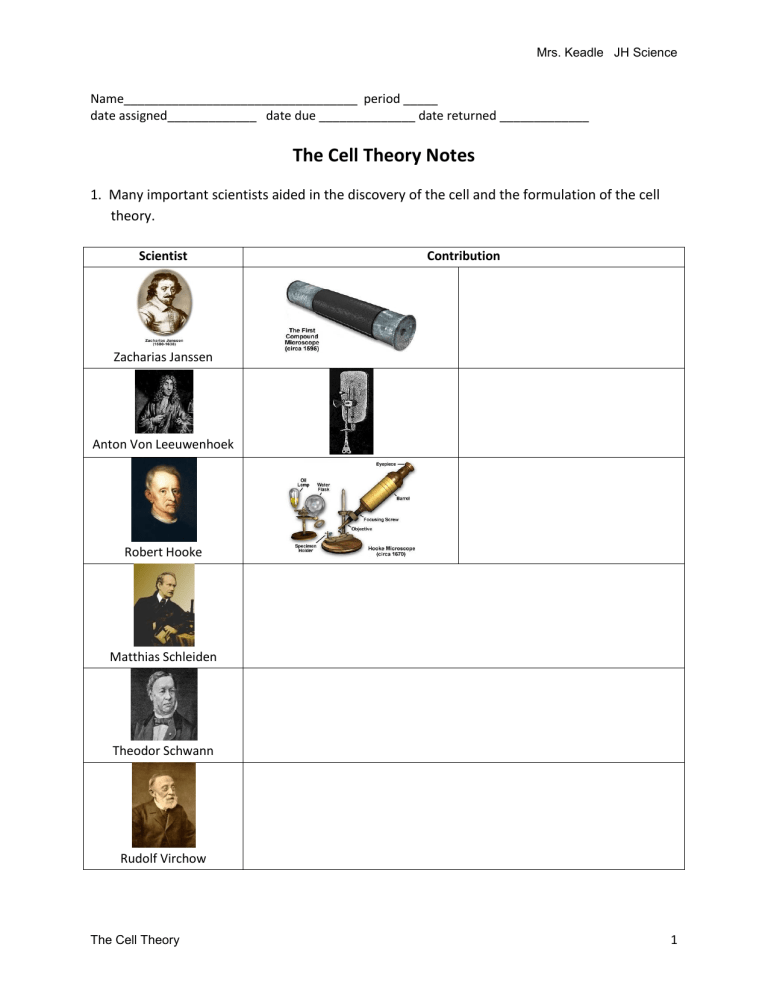
Mrs. Keadle JH Science
Name__________________________________ period _____ date assigned_____________ date due ______________ date returned _____________
The Cell Theory Notes
1. Many important scientists aided in the discovery of the cell and the formulation of the cell
theory.
Scientist Contribution
Zacharias Janssen
Anton Von Leeuwenhoek
Robert Hooke
Matthias Schleiden
Theodor Schwann
Rudolf Virchow
The Cell Theory 1
Mrs. Keadle JH Science
2. The Cell Theory a. all organisms are made of _____________________________________ b. ________________________ are the basic units of structure and function for all
_________________________ things c. All cells come from other _____________________________.
3. The cell is___________________________________________________________________
___________________________________________________________________________.
4. Prokaryotes are cells that do not have a ______________________
or other cellular ___________________________.
5. Eukaryotes have a ______________________ surrounded by a nuclear________________.
The Cell Theory 2
Mrs. Keadle JH Science
6. Unicellular organisms are composed of ___________________________ cell.
7. Multicellular organisms are made up of ___________________________cells.
Match the scientist with the correct letter stating his contribution to cell discovery.
_______ 1. Zacharias Janssen
_______ 2. Rudolf Virchow
_______ 3. Robert Hooke
_______ 4. Theodor Schwann
_______ 5. Anton Von Leeuwenhoek
_______ 6. Matthias Schleiden
A German histologist that concluded all
cells come from other cells
B German physiologist that concluded all animals
are made of cells
C Came up with the word "cell" after studying cork
under the microscope
D German botanist who concluded that all plants
are made of cells
E Dutch tradesman who made the first simple
microscope
F Dutch scientist that built a compound
microscope with his father.
Match the word with the correct definition.
_______7. prokaryote A. organism made up of many cells
B. cell that does not have a nucleus _______8. eukaryote
_______9. unicellular
______10. multicellular
C. cell with a nucleus
D. organism made up of one cell
The Cell Theory 3
Mrs. Keadle JH Science
Read the following passage and color the images on page 5 according to the instructions.
One of the most important general principles in the science of biology is the one known as the cell theory. Scientists use the term “theory” to indicate something that is more than just a hypothesis. A theory is a statement that has been proven true after many experiments. The cell theory was developed over many centuries by hundreds of scientists. It has been proven true so many times some scientists call it a concept.
The term “cell” was first used by English scientist Robert Hooke as he observed thin slices of cork under the microscope. He used the word cell because the compartments he saw in the cork reminded him of small rooms, called cells, used in monasteries and jails. The compartments in the cork were empty because the cells had died and disintegrated, but he also described cells in living plant tissues, which were filled with fluids.
Color the title “Cell Theory” black and the title “First Observed Cells” brown. Now color the title “Cork Cells” and the pictures labeled “A” a light brown. This is how Robert
Hooke drew the first cells he saw under a microscope.
In 1675 the Dutch scientist Antonie van
Leeuwenhoek discovered microscopic animals in water. He also discovered bacteria, which were not reported by anyone else for another 200 years.
Color the title “Microscopic Animals” and the small animals labeled “B” yellow. This is a reproduction of van Leeuwenhoek’s drawings.
Numerous scientists contributed various bits, large and small, to the final cell theory.
However, the credit for pulling it all together usually goes to a pair of German scientists.
In 1838 and 1839 the botanist, Matthias
Schleiden and the zoologist Theodor
Schwann proposed a hypothesis that all living organisms are made up of one or more cells and that those cells are the smallest thing that is alive. Since that time, thousands of scientists have examined millions of living organisms and have never found a single thing smaller than a cell that can function completely on its own.
Color the title “All Living Things Are Made of
One or More Cells” and the three cells labeled “C” green.
The idea that the cell is the basic unit of life was derived from the observation that the smallest thing that has all of the properties of life is a single cell. If the cell is broken open, the life processes stop.
Color the title “The Cell is the Basic Unit of
Life” and the cell labeled “D” blue.
In 1858 the German biologist Rudolf
Virchow supplied the third part of the cell theory when he stated that all cells come from the division of preexisting cells.
Although most scientists believe that the first cells spontaneously arose from chemical reactions when the earth was first formed, that occurred under very different conditions than those existing today and took a very large amount of time. Today we never see a cell produced except by division of a preexisting cell.
Color the title “All Cells Come From
Preexisting Cells” and the picture labeled
“E” purple.
4
The Cell Theory
The Cell Theory
Mrs. Keadle JH Science
5
11 Catherine needs to measure 2.5 mL of water to
make a model of a cell in science class. Which
of the following pictures best represents this
measurement?
A
Mrs. Keadle JH Science
12 All living things, plant or animal, have one
thing in common. Which of the following
is the common thing?
A They all have cells that are held up by
cell walls.
B They all have the same way to get
water and food into their cells.
C They all have cells.
D They all have special cells that can do
many different things.
B
C
13 In all living things, the presence of what
structure supports the cell theory.
A cell wall
B cell membrane
C vacuole
D chloroplast
D
The Cell Theory
6
